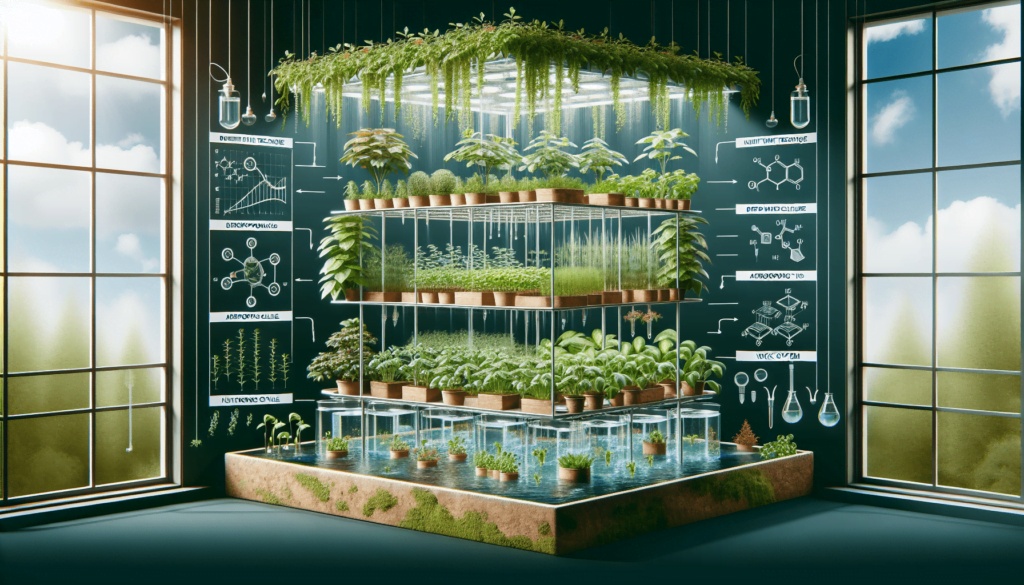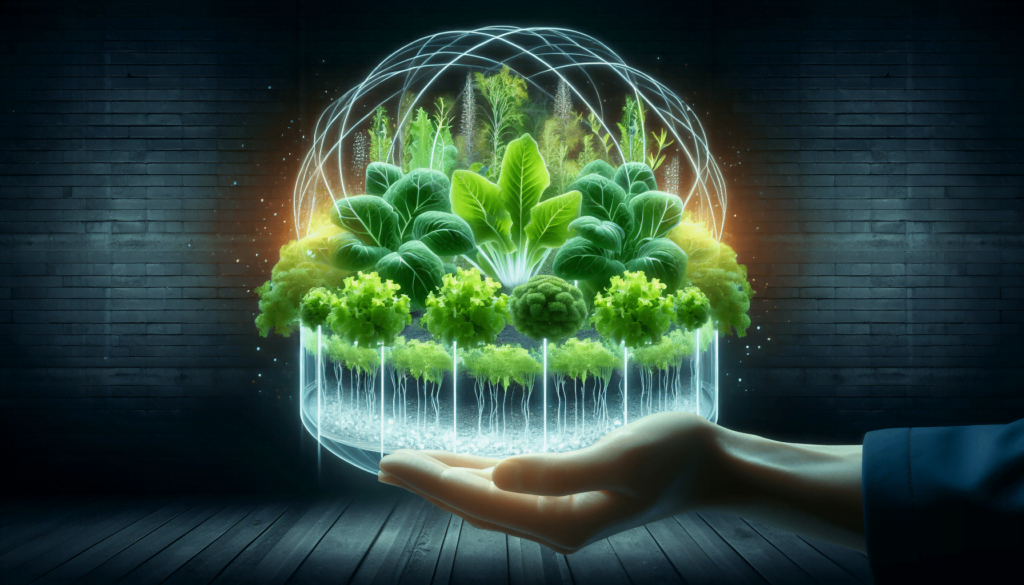As lovers of cultivation and greenery, we’re eager to shed light on a highly efficient and somewhat futuristic method for growing plants: hydroponics. Not only does this method allow us to grow plants year-round in an eco-friendly manner, but it also offers the chance to cultivate a wide variety of plants – including herbs and vegetables – right inside the comfort of home. We’ve put together a list of the top 10 benefits of growing plants hydroponically, proving why it’s an exceptional choice for both traditional gardeners eager to explore new methods and urban dwellers with limited outdoor space.
Understanding Hydroponics
Definition of hydroponics
When we mention hydroponics, we are speaking about a subset of hydroculture that grows plants in an aquatic-based environment or in an inert medium such as perlite, gravel, or mineral wool. Hydroponics involves supplying water, fortified with mineral nutrients, directly to plant roots, entirely circumventing the need for soil.
Brief history of hydroponics
Hydroponics is not a new approach; our ancestors have been experimenting with different forms of it for ages. In the hanging gardens of Babylonia and the floating gardens of the Aztecs, we can find early proof of the principles of hydroponics. However, it was not represented in mainstream agriculture until the 19th century when researchers began to uncover the mechanics of plant nutrition, ultimately leading to the development of nutrient solutions.
Different types of hydroponic systems
There are various types of hydroponic systems such as Wick Systems, Deep Water Culture (DWC), Nutrient Film Technique (NFT), Ebb and Flow (Flood and Drain), Aeroponics, and Drip Systems. We choose the type most suitable based on our specific needs, such as the crops we are growing, the space we have available, and the level of complexity we are prepared to manage.
Higher Crop Yield
Comparison of crop yield in hydroponics vs traditional farming
When we compare standard farming with hydroponics, we see a fundamental difference in productivity. Hydroponic farming often results in up to 30% higher yields than traditional farming. Such higher productivity is owing to the ability to control and perfect growing conditions, leading to less time reaching maturity while simultaneously maximising output.
Expected produce quantity in hydroponics
What’s wonderful about hydroponics is how we can predict the quantity of our produce accurately. All factors being equal, we can expect to yield approximately 20-25% more than under identical conditions in soil-based growing operations. This predictability naturally makes hydroponics an appealing choice for commercial growers and hobbyists alike.
Influence of controlled environment on crop yield
The significant influence on crop yield with hydroponics is the controlled environment. Hydroponic farming allows us to control every aspect of the growing process, from the nutrients to the pH balance to the temperature and light feedback. With this level of control, we can maintain optimal conditions for plant growth year-round, leading to high-quality, consistent yields.

Year-Round Production
Ability to grow crops regardless of season
One of the great advantages of hydroponics that we love is the ability to grow crops all year round. Unlike traditional farming, which is largely subject to seasonal fluctuations, hydroponics breaks free of the bondage of seasons and allows us to grow whatever we want whenever we want.
Influence of controlled environment on crop growth cycles
In hydroponics, we can control the plant’s environment to align with its specific growth cycle, leading to faster and healthier growth, irrespective of the outdoor weather conditions. The timing of light, temperature, and nutrients can all be manipulated to optimise plant growth and yield effectively and efficiently.
Examples of crops that can be produced year-round
There are numerous crops that we can produce year-round with hydroponics. These include varieties of lettuce, herbs like basil and mint, vegetables such as tomatoes, cucumbers, and peppers, and even strawberries. With a controlled environment, we can enjoy these fresh crops throughout the year.
Water-Efficient Growth
Percentage of water saved in hydroponics
A fantastic advantage of hydroponics, from an environmental perspective, is its water efficiency. Hydroponics uses up to 90% less water than traditional soil-based growing methods, making it a more sustainable option in water-scarce regions.
Explanation of hydroponic water-recycling process
In hydroponics, we use a water-efficient, closed-loop water system. This recycling process continually circulates water through the system, and any unused water is collected and re-used, resulting in minimal waste. Nutrient solutions can also be recycled, reducing both water and nutrient waste.
Environmental benefits of water conservation in hydroponics
The conservation of water in hydroponics has significant environmental benefits. For starters, with less water usage, there’s a reduction in the extraction of our precious freshwater resources. Plus, by recycling water, we are less likely to contribute to water pollution from agricultural runoff.

Space-Saving Techniques
The efficiency of vertical hydroponic systems
One of the great advantages of hydroponic systems that we find particularly ingenious is the possibility to create vertical farms. Vertical hydroponic systems allow us to utilise vertical infrastructure and multi-level shelving to grow plants, which can significantly save space without sacrificing yield.
Advantage of indoor space utilization
Hydroponics is an ideal method for making the most of indoor space. Given the fact that we can control the lighting, temperature, and humidity, we can grow plants in any indoor location – from a basement to a rooftop, maximising the use of otherwise underutilised spaces.
Examples of space-saving hydroponic designs
There are numerous examples of space-efficient hydroponic designs. The NFT system, for instance, with its unique design that involves a thin film of nutrient-filled water flowing over the roots, is a productive, space-saving system. Aeroponic systems, which utilise a mist or aerosol nutrient solution, are another example of space-efficient, high-yield designs.
Controlled Nutrient Application
Application of nutrients in hydroponic systems
In hydroponic systems, nutrients are applied directly to the roots, ensuring that the plants receive all the necessary nutrients. We administer accurately measured nutrient solutions for optimal absorption, promoting healthy and vigorous growth.
The precision level of nutrient application in hydroponics
The level of precision in nutrient application that we can attain in hydroponics is unprecedented. By using carefully calculated nutrient solutions, we can balance the pH and nutrient levels specifically for each plant species, thereby achieving peak performance from our plants.
Benefits of optimal nutrient application
With optimal nutrient application, we do not over-saturate plants with nutrients, something that is often a problem in traditional soil cultivation methods. Hydroponics allows plants to absorb exactly what they need, which leads to healthier growth, higher yields and better quality produce.
Fewer Pests and Diseases
Why hydroponics may reduce pest infestation and diseases
One advantage of hydroponics systems that we truly appreciate is their potential to reduce the risk of pest infestations and disease. Because most pests and diseases require soil to survive and proliferate, eradicating soil from the equation significantly reduces these risks.
Examples of pest and disease control in hydroponics
In hydroponic systems, we often employ preventative measures such as the use of beneficial insects, biodegradable pesticides, and mechanical barriers. Specific growing mediums such as coco coir and rockwool also help prevent pests and diseases by offering no habitat for harmful pathogens to thrive.
Impact on crop yield and quality
Reduced pests and diseases typically result in healthier plants and better yields. Diseased or infested plants suffer in vitality and production, while healthy plants provide not only higher yields but also better quality of fruits, vegetables, and herbs.
Faster Growth Rate
Comparison of crop growth in hydroponics vs traditional soil
Hydroponics provides an impressive boost to plant growth rates when compared to traditional soil-based cultivation. Because the plants are supplied with optimal growing conditions and nutrients, we often see up to a 50% faster growth rate in hydroponic systems.
Reasons for faster growth rates in hydroponic systems
Plants in hydroponic systems spend less energy searching for nutrients, water, and oxygen, so they can direct more energy into growth. Also, the controlled environment helps keep the plants at their optimal growing states, further enhancing the growth rates.
Examples of crops with fast growth rates in hydroponics
There’s a vast range of crops that exhibit rapid growth rates in hydroponic systems. Lettuce, basil, spinach, and several varieties of herbs and microgreens are just a few examples of plants that thrive and grow quickly in a well-managed hydroponic system.
No Soil Erosion
Explanation of how soil erosion occurs in traditional agriculture
Soil erosion is a severe problem in traditional agriculture where water runoff, often augmented by over-farming practices, strips the land of its upper, nutrient-rich soil layer. Erosion not only reduces the richness of soil for future crop growth but also contributes to water pollution and significantly impacts the environment.
How hydroponics helps prevent soil erosion
With hydroponics, soil erosion is a non-issue as no soil is used. By removing soil from the equation, the problem of soil erosion is entirely eliminated, making hydroponics an incredibly environmentally friendly way of cultivating crops.
Environmental benefits of preventing soil erosion
By eliminating soil erosion, we prevent the loss of fertile land due to degradation, maintain biodiversity, and prevent water sources from being polluted with runoffs. In an era where finding sustainable farming methods is crucial, the advantages of hydroponic system’s zero erosion rate cannot be overstated.
Potential for Large-Scale Farming
Why hydroponics can be efficient for large-scale farming
We believe that the inherent efficiency of hydroponic farming systems allows for substantial scalability. With the ability to precisely control conditions and maximise output while minimising resource usage, hydroponics presents an incredibly viable solution for large-scale, commercial farming operations.
Examples of efficient large-scale hydroponic farms
There are numerous examples of successful large-scale hydroponic farms around the world. From arid desert regions where traditional farming is a challenge to urban areas where space is at a premium, hydroponic farms are making a significant impact on the agricultural industry at an expansive scale.
Economic benefits and sustainability of large-scale hydroponic farming
In terms of economic benefits, large-scale hydroponic farming can reduce water usage and land requirements significantly, leading to lower operational costs and higher profits. Regarding sustainability, with hydroponics, we can create high-yield, environmentally-friendly farms even in regions with limited natural resources.
In conclusion, we strongly believe that hydroponic growing is a significant step forward for sustainable agriculture. As we all strive to create a healthier, sustainable world, the top benefits of hydroponic systems make it an exciting and eco-friendly avenue for future farming practices. Let’s all look forward to seeing the positive impact hydroponic farming will continue to have on our environment and our tables.
Forum
Got something to share or a question to ask? Jump in and start a conversation! Whether it’s tips, advice, or just sharing your experiences, we’d love to hear from you. Don’t be shy—your input could inspire or help someone else!- This forum has 1 topic, and was last updated 9 months, 3 weeks ago by .
- Topic
- Voices
- Last Post
- You must be logged in to create new topics.


